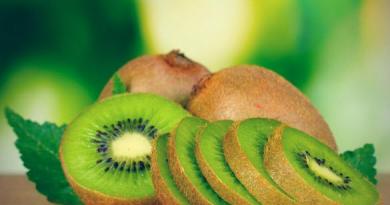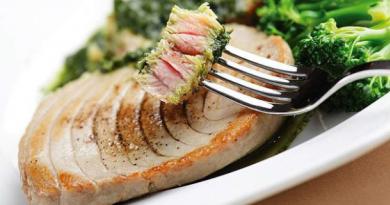Flounder is a fish that is found in the seas and rivers from the Arctic Circle to Japan. Due to its wide distribution, this bottom fish is known to fishermen and culinary specialists in Europe, the USA, Canada, and Japan.
Nature has formed the body of the flounder in an unusual way, the flat body of the fish is adapted to exist at the bottom. As a result, flounder meat has non-standard properties. Throughout history, man has used flounder for culinary and medicinal purposes.
Description of flounder
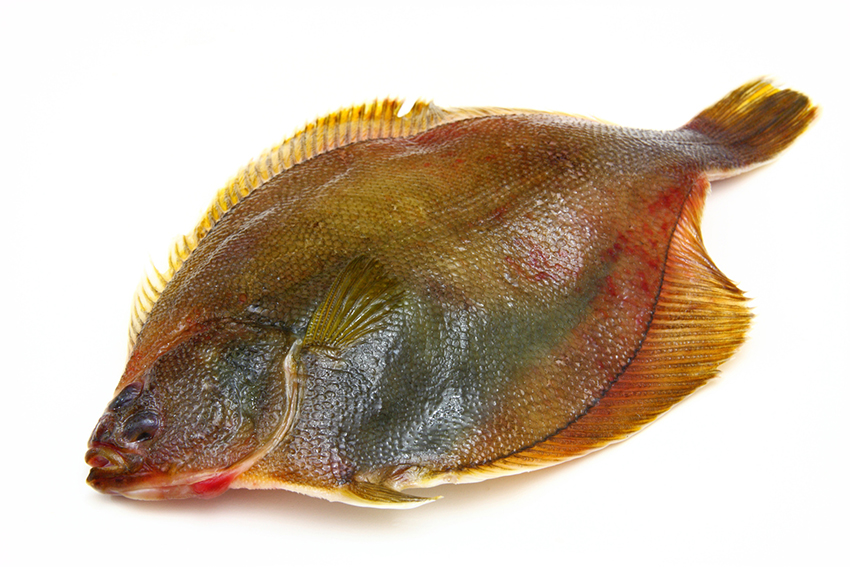 Flounder is a bottom predatory fish that lives in the seas and rivers of the Atlantic and Pacific basins, as well as directly in the oceans.
Flounder is a bottom predatory fish that lives in the seas and rivers of the Atlantic and Pacific basins, as well as directly in the oceans.
The fish has specific features:
- the eyes are located on the upper horizontal plane of the fish;
- marked asymmetry in the body
- eyes shifted to the right;
- the upper and lower planes of the body are colored differently
- the part facing the bottom is white, the top varies in color in different types of flounder;
- throughout the diameter of the body of the fish is equipped with a circular fin;
- there are auxiliary pectoral fins;
- the tail is short, slightly forked.
Interesting fact: the eyes of a flounder can move independently of each other
Adult fish reach 45 cm in length. Females are larger than males.
The most common types of flounder
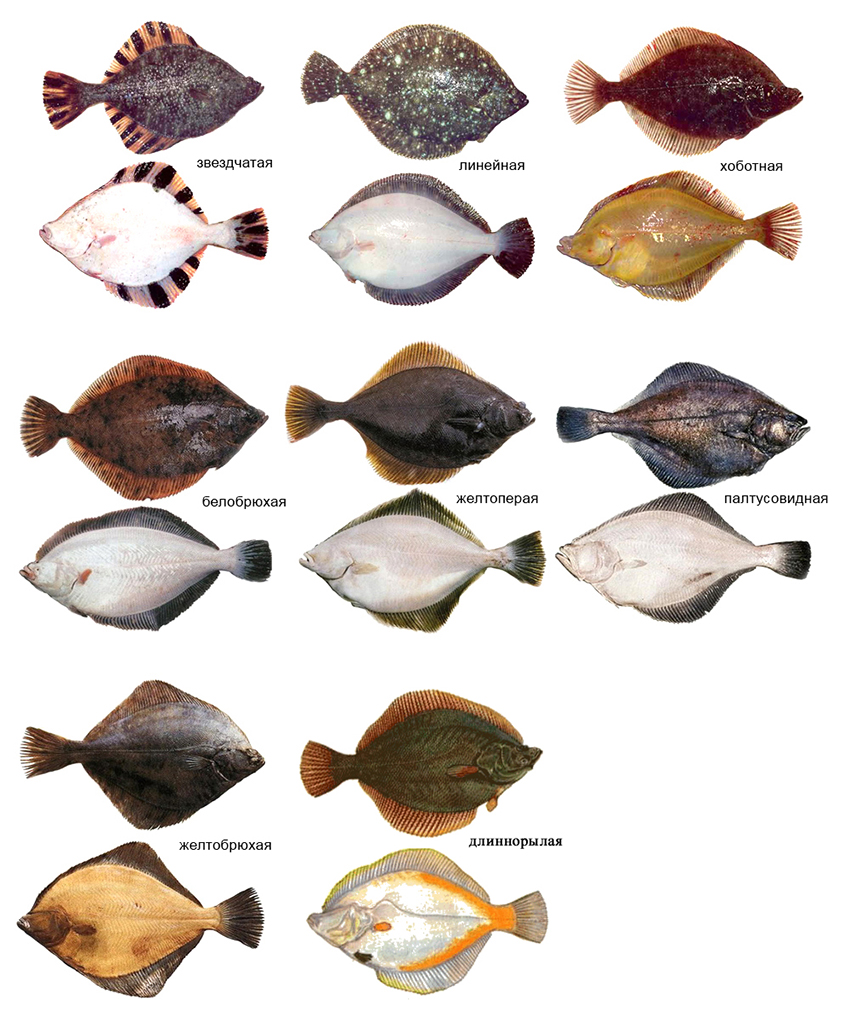 Ichthyologists described 30 species of flounder. In the fishing industry, two main varieties are classified - sea and river.
Ichthyologists described 30 species of flounder. In the fishing industry, two main varieties are classified - sea and river.
The main types of flounder:
- marine. Large fish (up to 7 kg of weight), found in almost all the seas of Northern Europe;
- river. It lives in the seas of Europe, enters the mouths of their rivers. Hunts in the sandy bottom. Color - greenish brown;
- white-bellied. It is found in the seas of the Pacific and Atlantic Oceans. It has a body curved in the form of an arc and a protrusion in the center of the upper plane;
- stellate. Distributed in the territory from Chukotka to Japan, but not numerous. Lives in river mouths, shallow bays. The eyes, unlike other flounders, are located on the left side of the head. In the diet of this type of fish, not only the usual prey, but also the waste of fish factories;
- yellowfin. The species is the most numerous. Individuals are relatively small - up to 500 g in weight. Yellowfin flounders live at the bottom in large flocks;
- polar. It lives in the northern seas, from Siberia to Norway. May enter river mouths. The species is distinguished by very small scales and an unforked tail. Often migrates in search of food.
flounder lifestyle
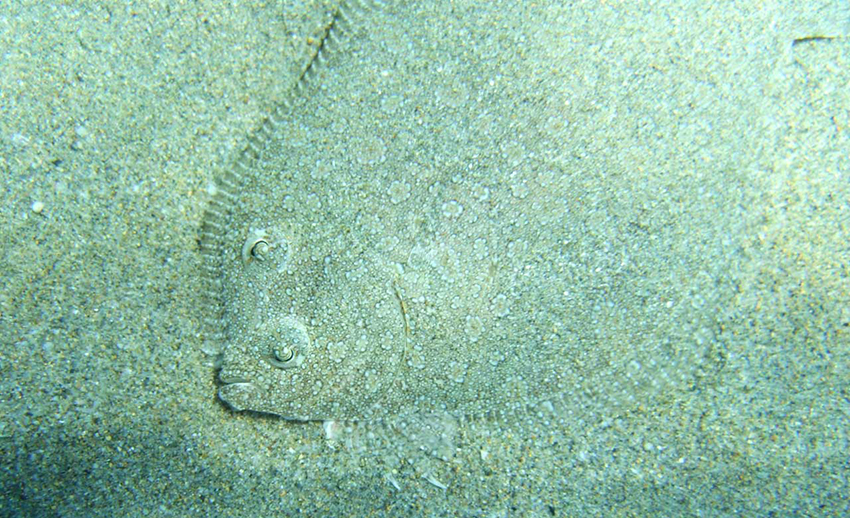
Muddy muddy places on the bottom, near moorings, piles, natural reefs. The main content of fish life is hunting.
Her loot:
- small fish;
- polychaete worms;
- crustaceans;
- shellfish.
Flounder can ruin the "roe nests" of other fish. The predator hides in secluded places of the bottom, waiting for its victims in an "ambush". It burrows into mud or sand with the help of its fins, leaving only its eyes on the surface.
The fish rarely leaves the bottom shelter, swims in a horizontal position, bending its body in waves. The flounder is awake and hunts only at night.
Interesting fact: flounder is the only fish found at the bottom of the Mariana Trench
The way of life has developed in fish the ability to mimic - to change the color of the upper body to match the color of the bottom. This helps the flounder to camouflage both from prey and from larger predators.
Natural enemies of flounder:
How to catch more fish?
For 13 years of active fishing, I have found many ways to improve the bite. And here are the most effective ones:- Cool activator. Attracts fish in cold and warm water with the help of pheromones included in the composition and stimulates their appetite. It's a pity that Rosprirodnadzor wants to ban its sale.
- More sensitive gear. Read the relevant manuals for the particular type of tackle on the pages of my website.
- Lures based pheromones.
- shark;
- acne;
- halibut;
- Human.
In spring spawning, the female flounder spawns up to 10 million eggs. Young fish do not yet have the characteristic asymmetry. They swim sideways, their eyes are placed on both sides of the head.
By the time of maturation (3 years of life), the body of a young fish is already taking a specific form. A healthy flounder survives in the wild for up to 10 years.
How to choose and store flounder
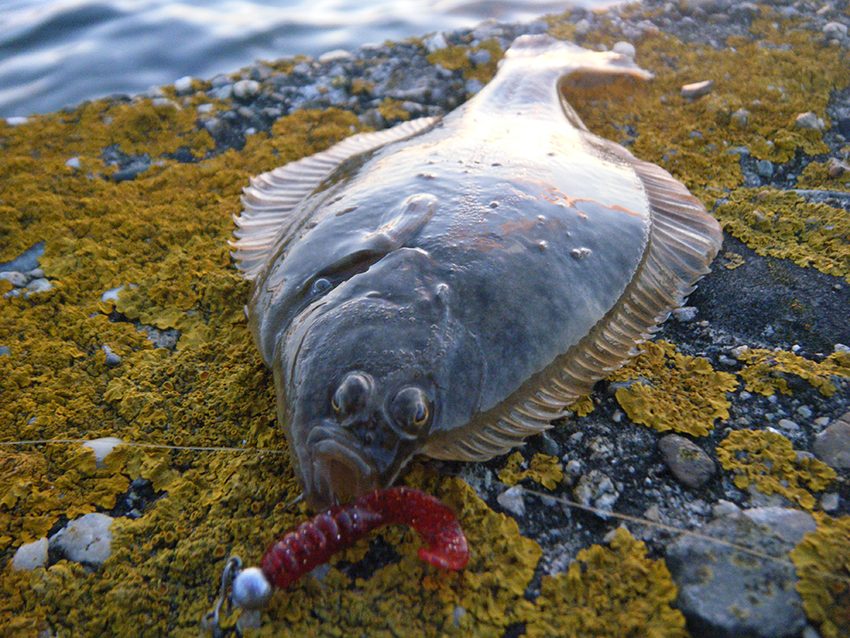
The best fish is not frozen. The freshness of flounder is easy to check by the following signs:
- the eyes of the fish are bright, clean;
- the flesh is elastic, springy from pressure;
- gills pink;
- from the sea flounder comes the smell of salt, from the river flounder - the smell of a pond.
But fresh flounder can only be purchased by residents of coastal areas. In cities far from the seas, fish is sold frozen. The advantage of flounder is that it is rarely cut into pieces before freezing.
You should choose a shiny carcass, without large ice crystals and white spots - “freeze burns”. Do not take fish that has been stored in the freezer for more than 3 months.
Acquired fish is preferably cooked immediately, as it does not have a dense structure. You need to store the flounder in the refrigerator, but not in the freezer, putting it on a flat plate or in a bag, and pouring it with broken ice.
Flounder in cooking, popular recipes
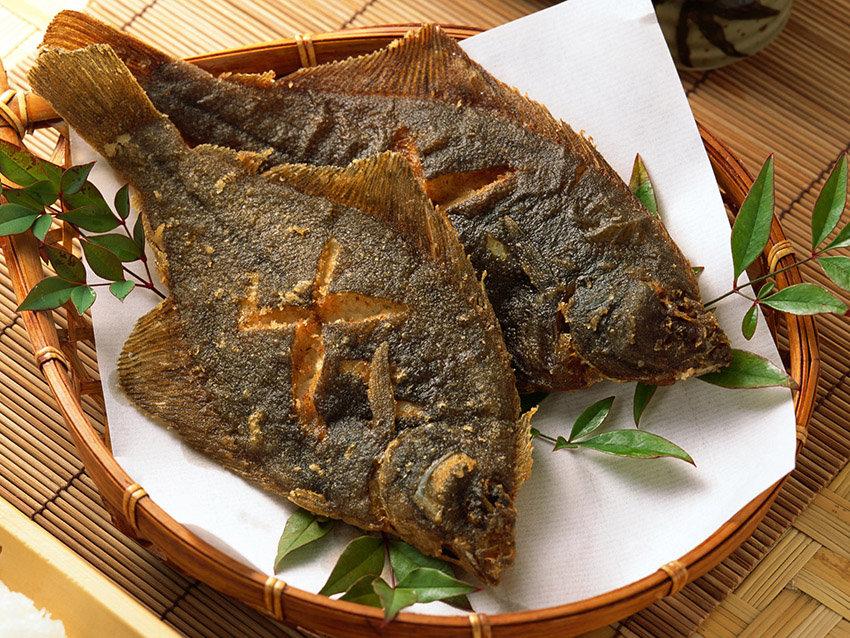
Tender sweetish flounder meat is cooked so easily that the fish can be used as the basis for an everyday dinner. Its mild flavor and unusual texture lends itself to many recipes.
- frying in a pan;
- grilling;
- extinguishing;
- pickling;
- baking.
The characteristic smell does not allow in soups. But it goes well with vegetables, potatoes, cheese, mushrooms, rice. The taste of flounder is well set off by spicy sauces - tomato, based on wine, horseradish.
Important! Flounder cannot be fried over high heat - it turns into porridge. Moderate heat will make the fish elastic and juicy.
Flounder is included in the traditional fish cuisine of Greece, Spain, Italy, Turkey, Japan, and the USA. In every kitchen there are simple and tasty dishes from this fish, for example:
- In a greased form, arrange layers of fried onions and garlic, pieces of flounder fillet, slices of fresh tomatoes and lemon, again pieces of fish. Add a few cubes of butter. Bake in the oven at 200 ° for no more than 20 minutes. So are the Greeks. You can serve ready-made fish with rice or fried zucchini, eggplant, boiled potatoes.
- Preheat oven to 175°. Put the flounder fillet in a greased form. Season with lemon juice, salt, pepper. Put slices of butter, cubes of tomatoes on the fillet, sprinkle with garlic powder and dried basil. Bake until the fish flakes easily with a fork. This is an Italian recipe, so you can serve fish with pasta or rice.
- American housewives put the flounder fillet in a plastic bag, add any hot sauce there and marinate for 1 hour in the refrigerator. Then the pieces of fish should be rolled in flour. The most beautiful color will give cornmeal. The flounder is fried in a non-stick frying pan, in a mixture of olive and butter. The fillet should be fried for 3 minutes. on each side. Cheese sauce and boiled potatoes go well with this recipe.
Nutritional value and calorie content of flounder
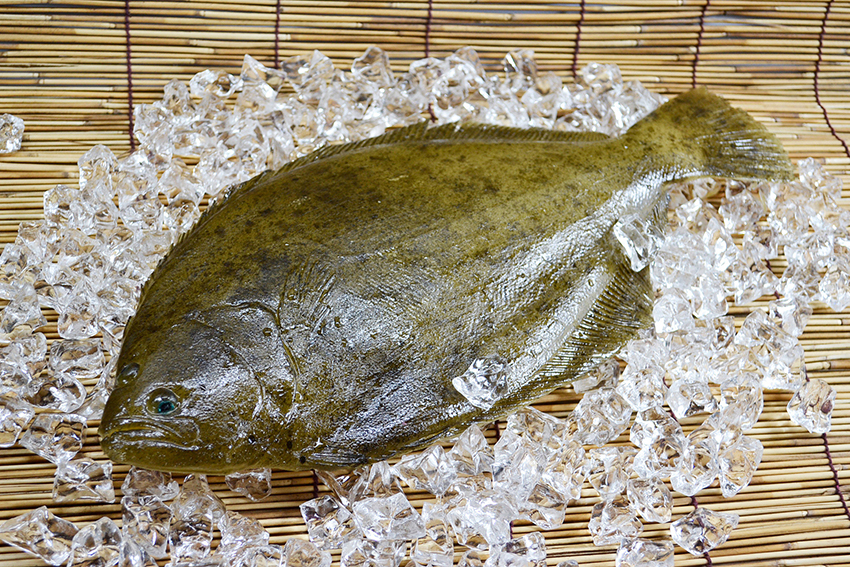
The flounder contains many elements valuable for human health. This is:
- a large proportion of minerals (selenium, phosphorus, magnesium, iron);
- a lot of vitamins B6, B12;
- unsaturated fats;
- absence of sugars.
For 100 g of fish, there are:
- fat - 1.5 g;
- proteins - 24.2 g;
- carbohydrates - 0.
From 100 g of flounder, a person receives only 117.3 kcal. Flounder fried in vegetable oil gives 201.81 kcal.
Gastronomic qualities and useful properties of flounder
Flounder meat is white and soft, with a lot of protein. It saturates well, but does not give weight gain. Benefits of flounder:
- high content of polyunsaturated fats, which protect human cells from aging and cancer;
- balance of useful minerals: iodine, phosphorus, iron, vitamins, selenium;
- useful cholesterol, which destroys plaques of harmful cholesterol on the lining of blood vessels;
- high content of selenium, which nourishes the human thyroid gland;
- complete absence of carbohydrates.
Important! Medium-sized fish contain more nutrients than large or small ones. The meat of fish weighing from 300 to 500 g is tastier.
Flounder is especially useful for pregnant women, the elderly, children and people who have had a serious illness.
What do we know about the benefits of flounder for human health?
![]()
Dietitians consider flat fish to be a medicinal product.
The composition of valuable substances makes flounder useful in diseases such as:
- hypothyroidism;
- cardiovascular diseases;
- chronic gastritis;
- cholecystitis;
- autoimmune diseases;
- chronic fatigue syndrome;
- anemia.
The benefits of flounder
In addition to dietary nutrition for chronic diseases, flounder is good in a regular diet.
Its beneficial properties provide:
- useful weight gain during pregnancy;
- quick recovery after serious illnesses;
- cancer prevention in the elderly;
- increasing mental performance, memory in schoolchildren and students;
- increase in sexual desire;
- improving the structure of hair and nails;
- cleansing the skin, increasing its turgor.
Harm of flounder
Fish, as a rule, does not harm health. The healing value of fish depends on the method of preparation. Flounder loses most of its useful properties when salted, smoked, canned.
Flounder prepared in these ways can harm various organs of the human body:
- Salted flounder retains fluid in the body, leads to edema and unhealthy weight gain;
- Salted flounder gives an excessive load to the kidneys;
- salted and dried flounder concentrates salt in the joints, which leads to arthritis;
- Smoked and canned fish are the focus of carcinogens.
Important! Dried flounder without salt retains almost all valuable substances. But dried fish should not be eaten by people with gastrointestinal diseases.
Contraindications
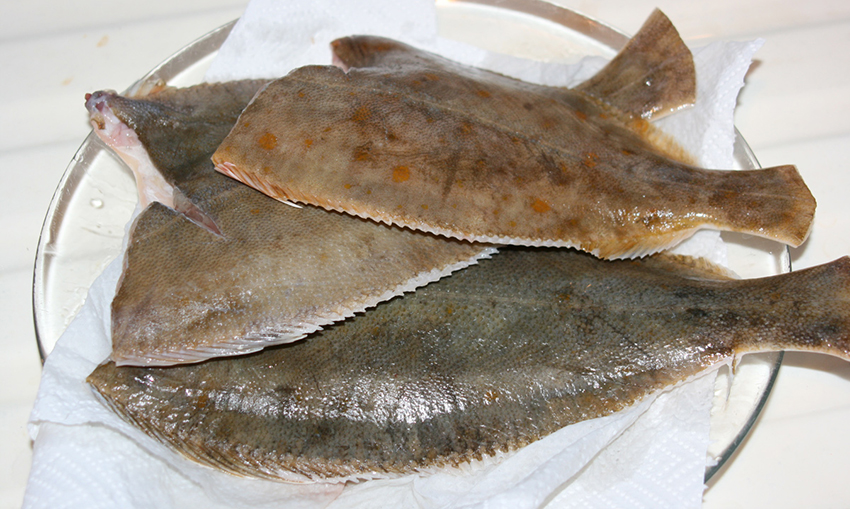
Flounder is contraindicated in specific cases:
- salted, smoked, fried in oil, dried flounder is contraindicated for people with diseases of the gastrointestinal tract, liver, gallbladder;
- salted, smoked fish should be excluded from the diet of patients with cardiovascular diseases;
- salted and smoked fish should be avoided by pregnant women and children under 14;
- salted, smoked, oil-fried flounder is contraindicated for people with metabolic disorders;
- flounder is forbidden to people who are allergic to fish.
flounder caviar
Flounder caviar is rich in vitamins A, D, E, F, lecithin, folic acid. These substances make it useful for:
- stimulation of brain cells;
- increase immunity;
- improve vascular elasticity.
Flounder caviar is salted, fried, stuffed with pancakes and covered with sandwiches.
Tip: if caviar is caught in fresh flounder, it must be squeezed out of the film with a fork before cooking.
Flounder has not only valuable dietary properties, but also a pleasant taste. These properties make fish popular in the national cuisines of many peoples. Baked, boiled and stewed flounder is useful for people of any age and health status.
Flounder: benefit and harm


